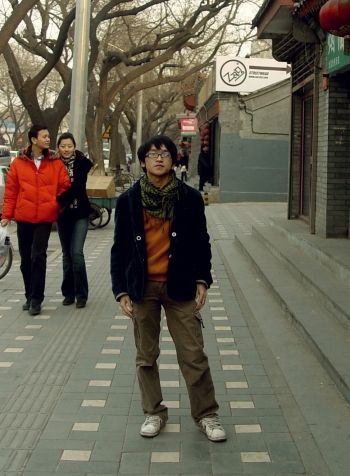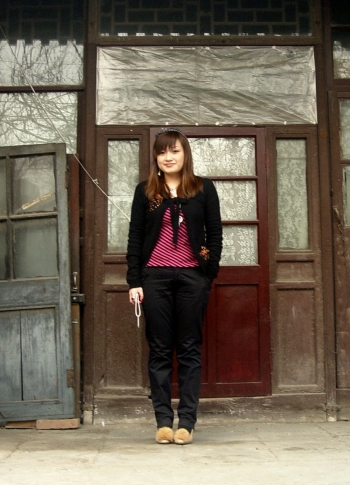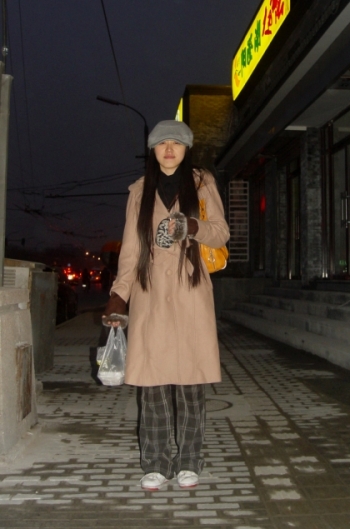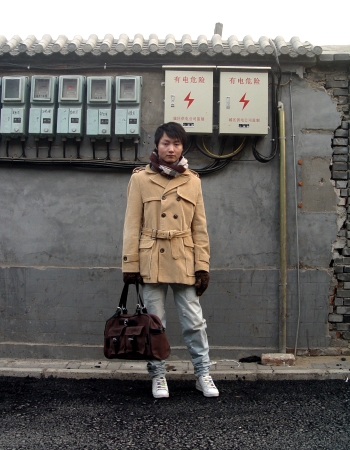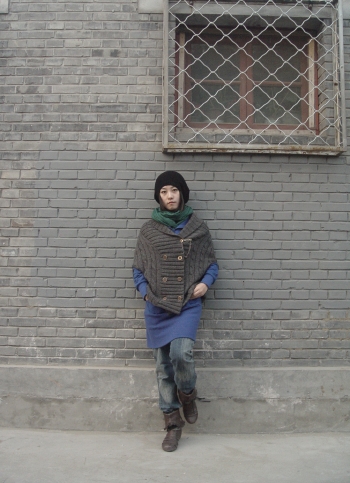April 30 2007 (06:53:00) US/Pacific ( 15 views )
![]()
This fellow was looking tough in Nanzhugan Hutong: He buys his rags at Xidan. His shoes are also from Xidan, and are made, he reports, by the brand Adidas.
(0) Comments | Post Comment
April 24 2007 (03:26:00) US/Pacific ( 22 views )
![]()
This is an artist from Qinhuangdao, in Hebei province. He was taking his daughter through the Long March Space at 798.
Do they support the troops?
(0) Comments | Post Comment
April 24 2007 (03:19:00) US/Pacific ( 8 views )
It’s always reassuring to slip into a pair of size 32s when your waist measures 36. However, the Chinese government will not allow the common practice of brands understating the measurements of the waists on trousers:
http://www.securities.com/doc.html?pc=CN&doc_id=135033322&auto=1&query=fashion%3A&db=en_1y_d&hlc=zh&range=365&sort_by=Date
(0) Comments | Post Comment
April 24 2007 (03:00:00) US/Pacific ( 7 views )
C&A, the Netherlands based rival of H&M and Zara, is coming to Beijing and Shanghai this year.
http://investing.reuters.co.uk/news/articleinvesting.aspx?type=consumerProducts&storyID=2007-04-20T070331Z_01_SHA337076_RTRIDST_0_SP_PAGE_016-SHA337076-OISCP.XML
They have no outlets in the US, perhaps because their style of clothing is not quite as “Euro-chic” as Zara, etc. They would run into direct competition with GAP. GAP is the world’s forth major fashion retail chain, and they still do not have plans to enter the China market. Maybe their clothes are too baggy for Chinese people, and it’s not worth producing a whole new line for this market.
In fact, it is interesting that all sources note that GAP has no presence in China, because up until two years ago there was a GAP as well as a Banana Republic (subsidiary of GAP) at the former Xidan Times Square, now called Maison Mode (and home to Gucci and other royalty). These two shops must have been operated through an agency. Maybe they were unsuccessful and that is why GAP is hesitant to enter this market.
To be frank, the style of C&A is a bit lame. That is not to say that it won’t catch on here, but I get the feeling that Chinese people really study the runway and hope to emulate its looks, hence the success of Zara. C&A may be competing with the likes of Baleno, JeansWest, Giordano and Metersbonwe – all distinguished local chains with a startlingly dull take on casual fashion.
Comments
“distinguished local chains with a startlingly dull take on casual fashion” Most if not all are HK chains IIRC?
Posted by Pescatore on 04/25/2007 02:34:04 AM
“distinguished local chains with a startlingly dull take on casual fashion” Most if not all are HK chains IIRC?
Posted by Pescatore on 04/25/2007 02:35:40 AM
Yeah, you’re actually right. But they still seem “local” in their sensibilities – maybe “local” meaning global boring-casual.
Posted by stylites on 04/26/2007 06:54:07 AM
(0) Comments | Post Comment
April 23 2007 (08:39:00) US/Pacific ( 4 views )
![]() (0) Comments | Post Comment
(0) Comments | Post Comment
April 23 2007 (08:32:00) US/Pacific ( 3 views )
“To appear well dressed, be skinny and tall.†— Mason Cooley
Being handsome helps, too.
Look below for the daily photos.
(0) Comments | Post Comment
April 23 2007 (02:22:00) US/Pacific ( 3 views )
At least not until haute couture runway shows come here:
“You can’t get emergency touchups from the workshop to the runway in a matter of minutes when you’re in Beijing.” Read the rest: http://www.smdailyjournal.com/article_preview.php?id=73911.
What remains of the hand-crafted couture in Paris.
(0) Comments | Post Comment
April 23 2007 (01:42:00) US/Pacific ( 3 views )
This guy is working with limited resources, on several fronts (money, exposure to global fashion trends, transport beyond feet and tricycle, etc.).
![]()
However, there is something about the eagerness to pose, and the swagger of this young fellow that made him Irresistible. I wish every stylish person was walking in front of this blue barrier, since it is a nice backdrop. This is just the type of person I would like to find more often. If you live here in China, his spirit and style might be old news, but I believe that this sort of attempt should be documented.
![]()
He was in front of a construction site in the hutongs south of Pingan Dajie. I would recommend a walk through that area as soon as possible.
![]()
I wonder if he would be interested in making a suit.
(0) Comments | Post Comment
April 20 2007 (01:44:00) US/Pacific ( 3 views )
Guess is opening its first store on the mainland tonight:
“Tonight, a grand inauguration party will be held at the Infiniti Mall on Huaihai Road M., where Guess opens its Shanghai flagship store, celebrating the American denim pioneer’s official landing on the vast Chinese market – that’s why Marciano is on his second trip to the city.
The company plans to open about 30 stores in China by the end of this year, 13 in Shanghai, 11 in Beijing, three in Hong Kong and a few more in Macau. The number is expected to expand to 55 by the end of 2008.”
Read the rest:
http://www.shanghaidaily.com/sp/article/2007/200704/20070420/article_313275.htm
The new Guess girl (Anna Nicole Smith launched her career by being a Guess girl) is going to be Chinese.
The article doesn’t mention that fake Guess products are already widely available on the mainland, but they are right to be sanguine about success here. The Guess look seems well-adapted to local style sensibilities. Guess’ cheaply baroque sexiness will have many takers. It will also help if they made sure to pick a Guess girl with big double-fold eyes.
“Guess” gets 16810 hits on taobao. I’m not certain that all of these are attempting to be the Guess that we know and love from the States, but the samples I have looked at seem to be.
http://search1.taobao.com/browse/0/t-95—————–g,m52wk43t—————-40-list-commend-0-all-0.htm
Comments
Alright then, maybe 1 store in Plaza 66, one store in Huaihai, 1 store in Xintiandi, 1 store in Xujiahui… ok that i could see… but 13-stores-is-a-fricken-lot when you are dealing with a market that is full of fakes and has minimal consumer differentiation is it not? Maybe I missed something? Why do I think this decision was made with the help of large amounts of yay and bubbly?
Posted by namrehsif on 04/20/2007 04:15:52 AM
Yeah, I hadn’t really reflected on that. And this is supposed to be by the end of this year. Hahaha. So guess would be the major foreign apparel chain in China after that. Hmmmm. Of all of the major US chains, it actually seems closest in style to the glitzy dross that most Chinese women already wear, so why would they pay extra for a somewhat mediocre brandname?
Posted by stylites on 04/20/2007 04:28:42 AM
(0) Comments | Post Comment
April 19 2007 (07:30:00) US/Pacific ( 3 views )
Last week, François Pinault, one of France’s richest men and the head of PPR, the world’s second largest luxury conglomerate after LVMH, denounced what he called France’s “Social Marxist culture.”
It’s not suprising that he or other CEOs would say this, as they relocate their production lines to China. I believe the French are the only electorate that understands what globalization means for citizens of the developed world.
Comments
It’s dated 1 January ’04? I am surprised those boots didnt make a bigger splash in the Paris of the East, which has a fairly solid track record of being obsessed with all things LV…maybe the colour being different threw things out of whack…
Posted by namrehsif on 04/19/2007 10:49:48 AM
(0) Comments | Post Comment
April 18 2007 (05:34:00) US/Pacific ( 3 views )
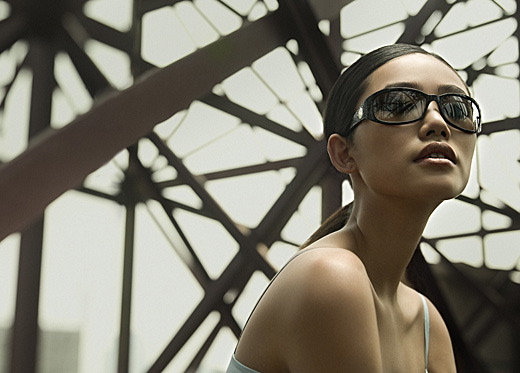
Chinese luxury good consumers will only wear Mandarin Collars after they are seen on Western fashion luminaries, according to this:
http://www.businessweek.com/print/globalbiz/content/apr2007/gb20070417_585340.htm
That is just one piece in the enigmatic puzzle that is the taste of Chinese consumers.
Comments
Interesting article. My first thought is that, in most cases, ‘China inspired fashion’ doesn’t sell in China. In the PRC, one tends to occasionally see ‘old chinese style’ ma gua and qipao stuff, and then there is also the communist-era clothing. The first style tends to make everyone look as though they are either someone going to a wedding, an idiot foreigner going out for a friday night on a dive bar street, or possibly, in the case of a qipao, a restaurant hostess, and I think that right now (speaking with regard to Shanghai), no self respecting person would wear such things on the high street in the light of day. The second type of ‘Chinese’ clothing one also tends to see are the post-revolution big bulky jackets, workmen’s hats and cloth shoes. Once again, no young trendy person (in Shanghai) would wear such things, as they are generally the garb of those 60 and older and physical laborers. Something along the same vein that I have seen as being popular with a certain type of college student is the ‘Wei Renmin Fuwu’ messenger bag/’Comrade Lei Feng’ T-shirt, but again most self respecting people will not wear such things. In closing I would say that Shanghai Tang is probably taking the right tack by using subtle rather than over the top Chinese inspiration for their clothes…good luck to them in making it work in the mainland.
Posted by namrehsif on 04/19/2007 02:53:48 AM
one addendum to the above: PLA green overcoats are awesome
Posted by namrehsif on 04/19/2007 02:57:01 AM
I would love to open a larger discussion of how Chinese fashion influences (and enters) mainstream global fashion. There are so many ways. What the commenter above says about the need to be subtle is on target. I would add to that by saying that the concept is important rather than the details. Collections that capture the essence of “Chineseness” are more successful than those that blatantly pick up Chinese elements like the collar or the tired old pop references to communism. Those collections that use poems, philosophical tracts, and paintings as inspiration for the ethos they are creating tend to be more aesthetically pleasing.
Posted by stylites on 04/19/2007 05:33:47 AM
(0) Comments | Post Comment
April 16 2007 (07:56:00) US/Pacific ( 5 views )
![]()
No angst, no evil, no frustration – these are not rebellious youths trying to shed darkness on their society. These were typical upbeat Qinghua girls eager to show off their English skills and their unique take on fashion.
(0) Comments | Post Comment
April 16 2007 (07:49:00) US/Pacific ( 3 views )
I brought back this bottle from France:
![]()
Here it is sitting by a haw, fruit-roll-up. You probably know about Vin de Pays. This particular bottle cost 79 Euro cents. According to Yuanyuan it tasted like its price, but I thought it was fine. Her senses of sight, taste, and smell are all more refined than mine though.
![]()
My sense of inebriation was alright. Which is classier the wine or my way of drinking it?
![]()
The obligatory crash into college girls out for a Sunday boat ride followed…But it wasn’t captured on film.
![]()
The walk around Beihai was nice.
![]()
This was a random girl walking through Beihai. She apparently comes through the park every Sunday to burn incense by an unmarked patch of grass where her great-great-grandmother is said to be buried. This woman was the court quicksand maker during the reign of Emperor Xianfeng.
![]()
And I left Beihai, not having offended the spirits of the court eunuchs in any truly unforgivable ways.
(0) Comments | Post Comment
April 16 2007 (02:38:00) US/Pacific ( 5 views )
China’s global luxury brand workshop
By Olivia Chung
HONG KONG – Don’t be surprised if you find the Prada, Armani or Burberry products you are wearing are made in China. Goods “Made in China” are no longer limited to cheap, low-end products. More and more brand-name luxury consumer goods are made in this “world’s workshop”, largely because of growing domestic demand as more and more Chinese can afford them.
According to a report by the World Luxury Association, more and more brand-name luxury goods are shifting their production to China. It expects that 60% of the world’s luxury brands will have
their products made in the country by 2009.
“This will be largely driven by the booming demand for luxury products by consumers in the Asia-Pacific region, particularly in China,” Ouyang Kun, representative of the association in China, was quoted as saying in China Daily.
He said the demand for such products in China was increasing by 15% annually. At present, the demand for luxury goods in China has already surpassed the manufacturing capacity of European makers by about 60%; therefore, they have had to shift their production to China, where labor and other costs are relatively low. In addition, this saves them the cost of shipping.
Sales in China’s luxury market hit US$2 billion in 2004, making it the world’s third-largest consumer of luxury goods, after Japan and the United States, according to a report by Ernst & Young. The report predicts that the market will grow by 20% each year until 2008 and then 10% annually to 2015, when sales are expected to exceed $11.5 billion.
Au Kin-fan, associate director of the Hong Kong Polytechnic University’s Institute of Textiles and Clothing, said seeing their competitors, one after another, shifting production to China’s low-cost environment to maximize profit forced other luxurious-goods makers to follow suit.
“However, foreign manufacturers usually shift part of their production line to China to cater for the growing demand there and keep their production bases in their home countries or other places to meet the global demand,” he said.
Foreign luxury-goods manufacturers started to shift part of their production line to China in 2004, and products made in China with foreign labels have flooded the Chinese market since 2005, said Ouyang: “Some luxury brands claim all of their products are made at home, but 60% of them are actually made in China.”
So far a number of fashion brands have gone public about shifting their production to China or have announced plans to do so. They include Pierre Cardin, Burberry, Armani, Prada and Furla.
The Chinese media have reported that French fashion brand Louis Vuitton plans to set up a production base in Zhejiang province this year. However, Janie Zhuang, public relations executive at Louis Vuitton China, said the firm does not produce any products in China at this time, nor does it have any plan to do so in the near future.
Au said one of the reasons for the international fashion brands keeping a low profile when shifting their production to China is the negative image of goods “Made in China”, which are often regarded as low-cost, low-quality products.
To avoid the possible negative impact on the brand value of their products, foreign manufacturers proceed with caution even if they shift only part of their production to China. For instance, their Chinese partners are assigned to produce mid-end products, or products made in China are sold under other brand names.
However, as globalization progresses, it’s not surprising to see a growing number of goods being made in more than one country before being put on the market. The nationality of a brand no longer has much to do with where the product is made.
Patrizio Bertelli, chief executive of Prada, has said that if his firm’s products were made in 10 countries, they should be labeled “Made by Prada” to give the brand the freedom to produce wherever it was thought appropriate.
This is because the most important aspects are design, quality and marketing – the production can take place anywhere, Au explained.
Au said more and more brands will relocate part of their production to China as other markets become saturated. Famous brands are struggling with a dilemma: the temptation to cut costs by shifting production to China and the sense of exclusivity that customers demand.
“Due to historical factors, it will take a long time for consumers to change their perception of the ‘Made in China’ label to a positive concept of being highly desirable from the existing perception of substandard quality,” Au said.
Before China began its market-economy reforms, factory workers were paid equally and there were no bonuses or rewards for superior performance, so whether the products were good or not did not matter to them, which led to serious quality problems. This attitude toward quality still persists to some degree.
According to China’s General Administration of Quality Supervision, Inspection and Quarantine, of about 9,000 goods that its quality inspectors sampled in the first six months of last year, 78% were found to comply with the relevant safety rules.
“To enable luxury brands with the ‘Made in China’ label to be well received, China needs stricter quality-control procedures, not to mention better technical and management skills,” Au said. “Quality control is key in every market.”
To illustrate how important quality control is, Au cited as examples some products of well-known fashion houses Armani, MaxMara, Burberry and Ermenegildo Zegna that failed to pass a quality inspection in China last year.
“This not only tells us that high price may not necessarily link to high quality, but also that international fashion makers are adopting a double standard when marketing their products in different countries,” he said.
“As China and other new and emerging countries for the fashion brands are only the mid-end markets, in order to capture a bigger market share, they mass produce and sell the products at not-so-high prices, so the brand products are of not-so-good quality,” he said.
However, Au stressed that where human health is concerned, the international brands should not employ a “double standard”.
In an examination carried out by the Shanghai Administration of Industry and Commerce last year, brands’ dresses, suits, coats and pants were found to be substandard. Problems included high levels of formaldehyde, a chemical that can cause cancer, unacceptable acid levels and poor dyes.
In addition to quality-control measures initiated by manufacturers themselves, China’s authorities should also improve health and safety regulations for all kinds of consumer products, which could help improve the average quality of the country’s exports and transform the “Made in China” image into something desirable, Au said.
As the major brands outsource production to almost every corner of the world, quality control could be a problem, so there is a need to increase consumer awareness of the need to make the right choices when shopping.
As for the “Made in China” label, Au said many makers of international brand-name products flocking to China in recent years have been quite satisfied with Chinese firms’ quality of production, reliability and management. It is, he said, time for the world’s consumers to take a new look at the “Made in China” label.
“With more overseas tourists coming to China, they will learn more about the great progress the country has been making and [have more] confidence in products made in China,” he said.
Olivia Chung is a senior Asia Times Online reporter.
Comments
Ha, Ha, I told you less than 6 mos ago that China would be producing high end goods because now they have the skills and the market is there too. You are right to want to be paid in yuan.
Posted by khavurta on 04/17/2007 01:20:51 AM
(0) Comments | Post Comment
April 12 2007 (07:35:00) US/Pacific ( 6 views )
Stepping out in snakeskin heels
Bold young designer Alison Mary Ching Yeung launched pricey “made-in-China” shoes named called “Imperial Funk,” all with purple leather soles. Snakeskin high heels are trimmed with mink – Yeung calls them “lush, powerful, yet fragile,” writes Michelle Zhang
Purple is Alison Mary Ching Yeung’s favorite color. The half-English, half-Chinese young lady wears no makeup, but has streaked her fringes purple.
According to Yeung, purple was the imperial color of the Chinese emperor, and represents opulence and decadence. The mysterious color, a combination of blue and red, is prevalent in the shoe designer’s first collection for autumn and winter: All the leather soles are purple. And she has named it “Imperial Punk.”
A capsule collection of 16 styles of sexy, glamorous shoes captures the eye immediately, possibly the soul, and perhaps eventually the wallet, when people step into the young designer’s spacious studio on Wulumuqi Road S.
“I started the collection drawing on scrolls and rice paper using ink,” she says. “I have been collecting imagery of Chinese emperors, lotus shoes, ceramics and furniture while absorbing the architecture and daily life in Shanghai. Then I contrasted the research with a fascination with punk fashion and pop art.”
Bearing the label “Mary Ching,” they come from a dark, plain palette of black, slate gray, chocolate brown and China red with exquisite and playful details.
For example, inspired by the penny loafer, the “Mao Loafer” is studded with Chinese one-jiao coins. A pair of simple flats is decorated with letters but when the right and left are placed side by side, they read “Shanghai.”
Yeung’s personal favorite is the “Empress Pearl,” a pair of fancy high-heels of snakeskin trimmed with mink. “Lush, powerful yet fragile,” she calls them.
Prices, however, range from US$260 to US$750, quite expensive for a starter in the industry. The 28-year-old is confident and ambitious: “I want to create the first international luxury shoe brand that is ‘made in China.”
She also wants to correct people’s association of the “made-in-China” label with shoddy, inferior products.
In fact, the “Mary Ching” brand philosophy is based on the belief that there will be a shift in perspective over the next 10 to 15 years towards a positive concept of “made in China” being highly desirable.
“People always presume that things ‘made in China’ are of poor quality, which is not true,” she says. “All my shoes are hand-made in China. When people see my collection, they are amazed by the quality.
“More and more luxury productions are reallocating to China and the customer is becoming more aware of this trend,” she adds.
The idea is to create shoes that combine the Asian aesthetic and European styles, using the finest materials from Italy and the local market, and are made with the top craftsmanship in China.
Yeung moved to Shanghai a year and a half ago as she saw vast possibilities in the market.
“Since I was a little girl, I have always dreamed of having my own fashion label one day,” she recalls. “So here I am now, working on fashion and following my dream.
“I think Shanghai is such an exciting city that the future of fashion is here,” she continues. “It is unlike any other major cities such as Paris, London and New York, where the fashion scene has already been established.”
And with white- and gold-collar income booming, she says, people are more likely to spend on brands and quality.
A graduate of the University of London’s King’s College in Business Management and Central Saint Martin’s in Fashion Design, Yeung understands both fashion and business. Not only has she worked with leading designers such as Julian Mcdonald, Hussein Chalayan and Ozwald Boateng, but she also worked as an investment associate at a London-based private equity firm, where she focused on the fashion industry.
The hard-working entrepreneur is meeting with interested buyers these days and has already framed a solid business development plan.
According to the plan, the “Mary Ching” label will be officially launched in September in the city. She plans to distribute it nationwide and expand gradually to other parts of Asia. The long-term plan is to bring the label back to her roots in UK and maybe one day to present it in United States. “I would like to create a ‘Chingdom’ one day,” she says, giggling.
Comments
Sounds tacky, but I guess you would have to see the goods to make a real decision. Will it sell? I don’t think I could see a person who can afford to pay $250 and up for a pair of shoes purchasing a pair of shoes covered with 1-jiao coins.
Posted by namrehsif on 04/12/2007 08:13:22 AM
You can get a quick glimpse of the “Imperial Punk” collection on Mary Ching’s website: http://www.marychingshanghai.com Personally, I can only say that I envy this designer’s obvious confidence and optimism. Some people are born with both qualities – a blessing in disguise sometimes.
Posted by Y Y on 04/13/2007 08:04:05 AM
YY seems to always leave subtly clever comments.
Posted by stylites on 04/13/2007 08:07:38 AM
and thanks for the link. This designer’s attitude has the key elements of success for young sino-foreign entrepreneurs making it in the new China.
Posted by stylites on 04/13/2007 08:11:18 AM
(0) Comments | Post Comment
April 11 2007 (02:02:00) US/Pacific ( 2 views )
Guess I will be going to Shanghai to get my colorful socks…
H&M hits Shanghai
(Shanghaidaily.com)
Updated: 2007-04-10 11:33
While Asians crave designer labels – often the name over the product – Swedish giant H&M successfully offers low-cost fashion for everyone. And it has just moved to China to prove that consumers are the same everywhere. Are they?
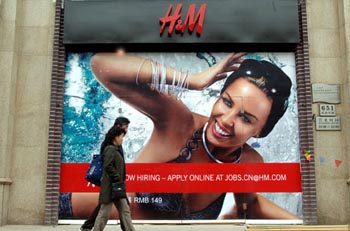
This undated photo shows two pedestrians pass by a big poster of Swedish giant H&M in Shanghai.[Photo:shanghaidaily.com]Asia is about to change,” declares Swedish fashion giant H&M as it finally expands to Asia – Shanghai next week – bringing its style of cheap and chic that has come to be accepted and admired by millions in Europe and America.
The Stockholm-based cut-price retailer opened its first store on the world’s most densely populated continent a month ago in Hong Kong. It opens two stores in Shanghai this month.
One store opens next Thursday in the former Benetton building on Huaihai Road M. and the other at the Superbrand Mall in Pudong on April 26.
But the big launch party for Asia and China will be in Shanghai next Wednesday night – not in Hong Kong.
Asia is known for its taste for luxury and designer brands among young professionals, but H&M hopes to change that, or at least hopes that the wardrobes for Asian men, women, teens and children will include a wide selection of its stylish apparel.
The H&M message is that trendy, stylish and tasteful doesn’t have to cost a lot of money.
“We believe that design is not a matter of price,” says Rolf Eriksen, CEO of H&M. “Our fashion is created for everyone.”
However, the launch party is clearly not for everyone. Coveted tickets to the event at Pudong’s Science and Technology Museum are sought by every fashion enthusiast in town.
Unlike Zara, which celebrated its flagship store opening in a rather low-key way, H&M plans to throw a huge, one-of-a-kind party. Australian pop diva Kylie Minogue has been invited to make her debut on the Chinese mainland, promoting “H&M loves Kylie,” a limited beachwear line.
According to Eriksen, H&M spends about three percent of its annual turnover on advertisements in one market.
From the amount of money the company is going to spend on the party – and what it has spent on the gigantic billboards suddenly flooding the city – its expectation for the Chinese market is obvious.
“China is a strategic and exciting market with great fashion awareness and spending power,” he says.
“We therefore see a vast potential for expansion.”
As one of the world’s leading apparel retailers, H&M has chosen China to lead its development in Asia.
Apart from its first store in Hong Kong and two in Shanghai, another three will open in Hong Kong by the end of the year. The first store in Japan will open in Tokyo in 2008.
“Looking into the future, we think it’s necessary to enter new markets,” says CEO Erikson. “We chose Hong Kong and Shanghai because we are familiar with the two cities, where we have our production offices present for 30 years and 25 years respectively.
“It’s a big step for us to enter the Far East,” he continues. “The Asian market is huge. It could be one of the key markets for H&M in the future. However, we prefer to start slowly and plan carefully for further expansions.”
He says the company has learned a lot in the US market, where it opened its first emporium on Fifth Avenue in New York City seven years ago. The Manhattan store was such a success that the company thought it could open much bigger stores in the US than in Europe.
“We did make some mistakes with the US market at the very beginning,” he says.
“The stores we opened at that time were too big, which brought about problems. We changed our strategies and have also gradually learned how to operate long distance business from the US market.”
The ideal development mode in China would be operating a couple of stores to collect necessary market information first.
Shanghai, or “China’s Paris” as Eriksen puts it, will be the center. The company will consider moving to other cities after the Shanghai market is established.
“We are not in a rush,” the CEO emphasizes. “The most important thing is to make sure that Chinese customers like H&M. We believe that fashion behavior is the same all over the world, be it Paris or New York, Hong Kong or Shanghai.”
H&M, the second-largest clothing retailer in Europe, will compete in the surging local retail market with Spain’s Zara and Mango, Germany’s C&A as well as a raft of local brands such as the Hong Kong-based Esprit.
“Just like fashion, competition is worldwide,” Eriksen says. “Every time we enter a new country, there will be local competitors and worldwide competitors.
“Our business idea is to offer the customers fashion and quality at the best price. We understand the customers would like to see our competitors around us. It’s up to them to judge which they prefer.”
(0) Comments | Post Comment
April 06 2007 (10:11:00) US/Pacific ( 3 views )
Last Monday, Benny from Beijing Radio’s English language service interviewed me about this blog. The interview will be on air between 8pm and 8:30pm on Monday (4/9) and Tuesday (4/16).
The frequency is am774.
You can also listen to it on the website: www.bjradio.com.cn. Click on 外è¯å¹¿æ’ on the blue board that is toward the right side of the page.
I had the honor of being the first interviewee in this series on foreigners based in Beijing who blog.
(0) Comments | Post Comment
April 05 2007 (05:02:00) US/Pacific ( 2 views )
On US ebay, there are 534 entries for “Paul Smith” in Men’s Clothing, accessories, and shoes. I believe that many of the items selling here are fakes or over-production made in China.
On Taobao.com, China’s premier online retail site, there are 15,729 entries for “Paul Smith” in the same categories. Almost all of these entries are for multiple items – that is you can pick the size, style, etc.
Needless to say there are far more retail points at which Paul Smith products can be purchased in the US than in China.
(0) Comments | Post Comment
April 03 2007 (02:20:00) US/Pacific ( 3 views )
![]()
In a city with such fine wines, I still chose what I know and hate. I need more of a kick to take me through a day of sightseeing.
![]()
I think this came out alright.
![]()
Yuanyuan made a lovely dinner in our cute little flat in Les Halles. Sancerre is a very common but good white wine in France. It is impossible to find it here so I brought several bottles back in my luggage.
(0) Comments | Post Comment
April 02 2007 (06:59:00) US/Pacific ( 2 views )
Finally, the newest Erguotou series from Paris.
![]()
Xiao’er before Notre Dame
![]()
Xiao’er & Jardin Luxembourg
![]()
(0) Comments | Post Comment
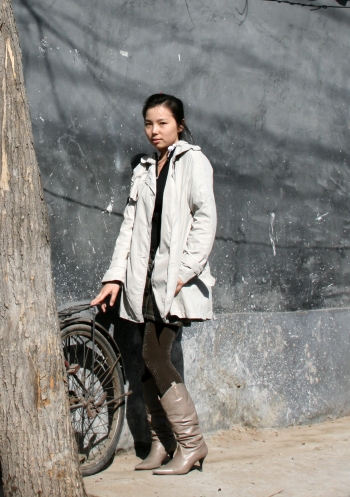
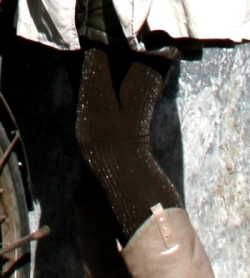
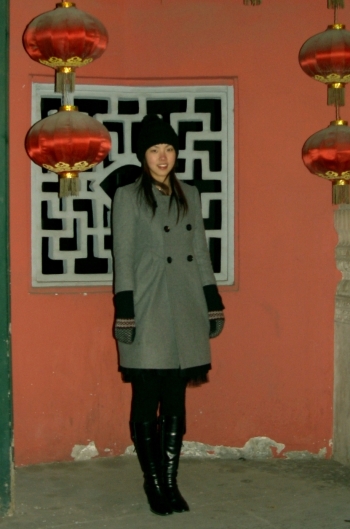 In a winter of ankle-length puffer coats, boots with ten buckles, and extended glimpses of wool long-johns above low-rise jeans, this simple but cute and warm-looking ensemble was inspirational. Many Beijing girls have got the looks, but this economics student actually dresses to bring them out. Still, her mother wouldn’t be happy, since legs are a crucial body parts to keep warm, according to Chinese tradition.
In a winter of ankle-length puffer coats, boots with ten buckles, and extended glimpses of wool long-johns above low-rise jeans, this simple but cute and warm-looking ensemble was inspirational. Many Beijing girls have got the looks, but this economics student actually dresses to bring them out. Still, her mother wouldn’t be happy, since legs are a crucial body parts to keep warm, according to Chinese tradition.